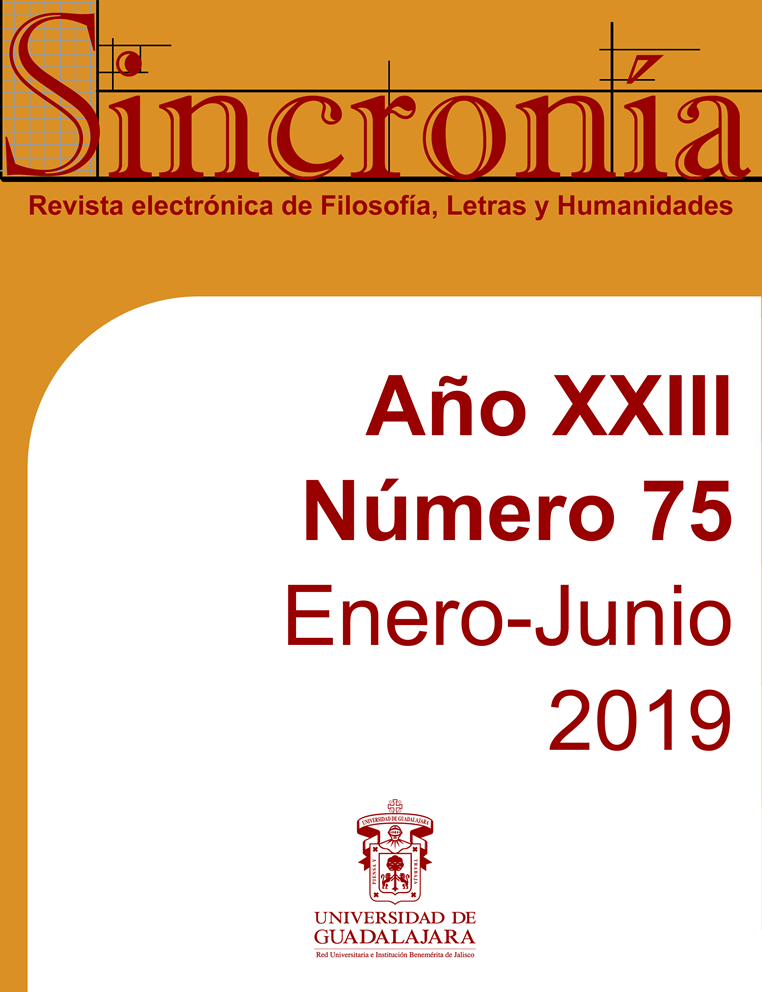Instant’s butterflies: stylistic and pragmatic aspects in Jose Juan Tablada’s synthetic poems.
Keywords:
Tablada., Haiku., Stylistics., Pragmatics.Abstract
A century after the publication of Un día… Poemas sintéticos by José Juan Tablada in 1919, we revisit the concept of “poetic synthesis” from a literary pragmatic standpoint (mainly the ideas of Sperber and Wilson and Escandell Vidal) which was proposed by the author and debated by Ramón López Velarde. We consider in this study that the so-called "haikus" of Tablada evolved into two styles in easily distinguishable by their rhetorical and pragmatic elements: a maximalist style and a minimalist style. Both styles reveal a persistent tension that lies within the aesthetic ideas of the Mexican poet.
Downloads
References
Arai, K. (2013). How Can We Translate Invisible Constituents in Haiku. Translation Ireland, 19 (1), 65-76.
Arellano, D. (2010) Aproximación a la naturaleza del haiku mexicano (Tesis de licenciatura). México: UNAM.
Cabezas, A. (2007). Jaikus inmortales. Madrid: Hiperión.
Cantella, B. (1979, octubre-diciembre). Del modernismo a la vanguardia. Estética del haikú. Revista Iberoamericana, 639-649.
Ceide, G. (1967). El haikai en la lírica mexicana. México: Ediciones de Andrea.
Escandell, M. V. (1994). La noción de estilo en la Teoría de la Relevancia. En Elsa Dehennin y Henk Haverkate (Dir.), Lingüística y estilística de textos. Amsterdam: Rodopi, p. 55-64. ESTRADA, G. (1983) Un raro de la literatura americana. Obras, México: FCE, p. 333-336.
Galván, D. (1983). José Juan Tablada y su haikú: aventura hacia la unidad. Cincinnati Romance Review, 2, 110-120.
González, E. (2002). La apacible locura. Obras 3, México: El Colegio Nacional.
Gordon, S. (2003). Estéticas de la brevedad. Revista Fractal, 3. Obtenido el 26 de septiembre de 2018 desde https://www.mxfractal.org/F30gordon.html
Grice, P. (1991). Logic and conversation. En Paul Grice, Studies in the Way of Words, Cambridge: Harvard University Press, p. 1-144.
Hernández, E. (1991) José Juan Tablada: un infractor del hai-kai. Literatura mexicana, 1 (2), 393-420. LÓPEZ VELARDE, R. (1990). Obras. México: FCE. MONDOR, H. (1941). Vie de Mallarmé. París: Gallimard.
Ota, S. (2005). José Juan Tablada. La influencia del haikú japonés en “Un día…”. Literatura Mexicana, 16 (1), 133-144.
Ota, S. (2014). José Juan Tablada: su haikú y su japonismo. México: FCE.
Page, J. (1963). José Juan Tablada, introductor de haikai en Hispanoamérica (Tesis doctoral). México: UNAM.
Page, J. (1992, septiembre-diciembre). José Juan Tablada y el anti-haiku. Estudios de Asia y África, 89 (3), 509-512.
Pascucci, M. (2013, septiembre). Las “fuentes chinas” de José Juan Tablada: revelación y reevaluación. Hispania, 93 (3), 481-492.
Paz, O. (1957). Estela de José Juan Tablada. Las peras del olmo. México: Imprenta Universitaria.
Pilkington, A. (2000) Poetic Effects. Ámsterdam: John Benjamins.
Renaldi, T. W. (1979, enero-marzo). Imágenes vanguardistas entre formas modernistas. Texto Crítico, 5 (12), 253-260.
Ricoeur, P. (2001). La metáfora viva. Madrid: Trotta.
Rodríguez-Navas, M. (1918). Diccionario general y técnico hispano-americano. Madrid: Cultura Hispanoamericana.
Sperber, D. y Wilson, D. (1995). Relevance. Communication and Cognition. Oxford: Blackwell.
Tablada, J. J. (1991). Obras I. Poesía. México: UNAM.
Tablada, J. J. (1997). La feria de la vida. México: Conaculta.
Tablada, J. J. (2007). De Coyoacán a la Quinta Avenida. México: FCE.
Tablada, J. J. (2008). Un día… Poemas sintéticos (edición facsimilar). México: Conaculta.
Tanabe, A. (1981). El japonismo de José Juan Tablada. México: UNAM.
Valdés, H. (1991). Prólogo. En José Juan Tablada. Obras I. Poesía. México: UNAM.
Wilson, D. (2011). Relevance and the Interpretation of Literary Works. UCLWPL, 1, 69-80.
Downloads
Published
How to Cite
Issue
Section
License
Copyright (c) 2019 Manuel Alejandro González Palomares

This work is licensed under a Creative Commons Attribution-NonCommercial 4.0 International License.
You are free to:
- Share — copy and redistribute the material in any medium or format
- Adapt — remix, transform, and build upon the material
- The licensor cannot revoke these freedoms as long as you follow the license terms.
Under the following terms:
- Attribution — You must give appropriate credit , provide a link to the license, and indicate if changes were made . You may do so in any reasonable manner, but not in any way that suggests the licensor endorses you or your use.
- NonCommercial — You may not use the material for commercial purposes .
- No additional restrictions — You may not apply legal terms or technological measures that legally restrict others from doing anything the license permits.




























